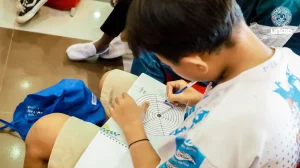The term superfood refers to food that is rich in nutrients and has a positive impact on the body. One of the most popular superfood as food supplements is Spirulina. This blue-green alga is quite famous as it is rich in fatty acids omega 6 and 3, vitamin B1, vitamin B2, vitamin B3, iron, and other minerals. Aside from being a supplement for humans, this material can also be used for clownfish because it has the same habitat, sea waters.
Known for its bright orange color with three black and white lines, the clownfish became increasingly famous especially after being appointed as the main character of several animated films. The bright color of clownfish is caused by carotenoids, a pigment produced by all photosynthetic organisms and fungi, including microalgae. The color intensity of fish is also influenced by internal factors such as the age of fish and external factors such as water quality, light intensity, and feed containing carotene and nutrients.
As a result, the demand for this fish has increased dramatically. For cultivation, this is advantageous because the market is available, but maintaining the effectiveness of costs in aquaculture is certainly another matter.
Spirulina is a superfood
The brightness of the fish color is strongly influenced by the number of carotenoids. The color of the fish generally will be brighter to a certain age, then it decreases. Therefore, it is vital to maintain the number of carotenoids. Moreover, this material cannot be produced by the body of the fish. Spirulina, which is rich in carotenoid and phycocyanin pigments, is very good for ornamental fish in cultivation. The consideration for combining cheaper and nutritious superfood came up to replace fish meal, the main ingredient of feed, which is expensive. The question is, what percentage of fish meal can be substituted by this superfood?
To answer this question, we conducted research for 60 days. We used three replications, 3 Spirulina flour treatments and one negative control without Spirulina. Besides, we use two different maintenance environments, indoor (indoor) and outdoor (outdoor). The use of different maintenance conditions is used to ascertain whether environmental factors, in this case, the light intensity and water quality affect the color intensity of the clownfish.
Spirulina used was 0.9%, 1.2%, and 1.5% for each treatment. Spirulina flour is mixed with fish meal, soy flour, cornflour, wheat flour, fish oil, corn oil, and premix. The feed is then proximate to determine the nutrient content of the feed.
The food was produced with 2-3 cm long and given four times a day. Growth monitoring (length and weight) is carried out every ten days. To monitor body color, the M-TCF (Modified Toca Color Finder ) method is used. This method uses color observations carried out by five different people at the beginning and end of maintenance. The five people must have normal vision. Clownfish is compared to the color guidelines available at M-TCF, each of which has a score. Lower scores indicate brighter colors. For comparison, histological analysis of chromatography was also carried out at the beginning and end of maintenance.
There is an increase in color on the 30th day because the fish has adapted to the maintenance environment. The color intensity of clownfish increases with the addition of 1.2 – 1.5% Spirulina flour even though the increase was not significant when it was analyzed statistically.
In line with the color, the growth and survival of clownfish did not show a significant difference. Some fish die from bacterial disease infections. This conclusion can be drawn because dead fish have several symptoms such as swimming apart from the group, pale body and organ color and swelling of the liver and kidneys. The content of phycocyanin in Spirulina is an immunostimulant, which stimulates the production of red blood cells. As a result, clownfish are more resistant to disease and their survival is higher when Spirulina is added to their feed. However, this superfood is not very super to increase the color intensity and growth of clownfish.
Author: Syifania Hanifah Samara, S.Pi., M.Sc.
Details of this research available at:
https://iopscience.iop.org/article/10.1088/1755-1315/236/1/012073
Siti Hudaidah, Berta Putri, Syifania Hanifah Samara, and Yudha Trinoegraha Adiputra (2019). Effect of partial replacement of fish meal with Spirulina platensis meal in practical diets and culture location on growth, survival, and color enhancement of percula clownfish Amphiprion percula. IOP Conf. Ser.: Earth Environ. Sci. 236 012073; https://doi.org/10.1088/1755-1315/236/1/012073









